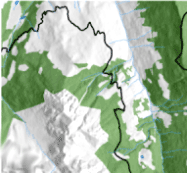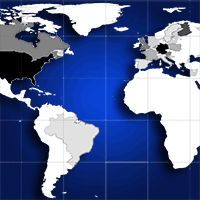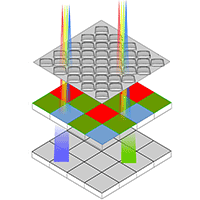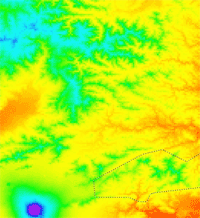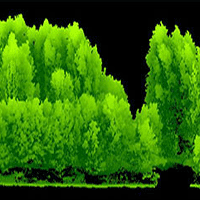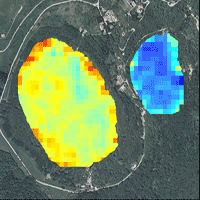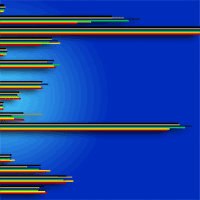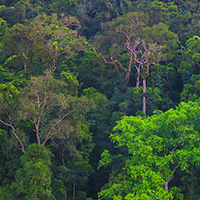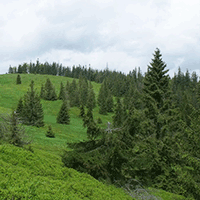
Historical and contemporary forest ecosystem changes in the Beskid Mountains (southern Poland) between 1848 and 2014
Michal Sobala, Oimahmad Rahmonov , Urszula Myga-Piatek
iForest - Biogeosciences and Forestry, Volume 10, Issue 6, Pages 939-947 (2017)
doi: https://doi.org/10.3832/ifor2418-010
Published: Dec 19, 2017 - Copyright © 2017 SISEF
Research Articles
Abstract
Landscape changes in the Carpathians are related to centuries of human activity, which can be regarded as the key component of global change. Changes in mountainous regions are mainly caused by agriculture, urbanization, forest cutting for production and land abandonment. This paper aimed to assess the impact of natural and historical-cultural factors on forest ecosystem transformations occurred in the period 1848-2014 in two small areas (about 45 km2) on the Beskid Mountains (southern Poland). The comparison of historical and current maps, along with the application of GIS and field verification, allowed a full interpretation of changes in land use in the studied areas. A decrease of 58.0% in non-forest areas was observed in the considered period, while the forested area grew systematically by 28.3% and the forest-field boundary lowered in altitude. Current forest ecosystems are distributed as a mosaic and mainly consist of Dentario glandulosae-Fagetum, Luzulo nemorosae-Fagetum, Abieti-Piceetum montanum, with logged sites taking up large areas. Forest ecosystems include valuable semi-natural meadows such as Gladiolo-Agrostietum, Hieracio-Nardetum, Arrhenatheretum medioeuropaeum, Cirsietum rivularis or Juncetum effusi, whose extension is reducing and fragmentation increasing due to the recolonization of forest tree species after abandonment. We concluded that trends in land use in the Carpathians were mainly determined by non-environmental factors related to the development of farming-pasturing and forest management. The applied approach could be extended to other regions in the Carpathians which were subject to analogous historical-cultural influences. Moreover, our results allow for a comparison with other regions which are subject to similar impacts of natural processes, but to different impact of historical and cultural processes.
Keywords
Landscape Research, Forest Transformation, Land Use Changes, Historical Maps, Poland, Beskid Mountains, Carpathians
Authors’ Info
Authors’ address
Oimahmad Rahmonov
Urszula Myga-Piatek
University Silesia in Katowice, Faculty of Earth Sciences, Bedzinska 60, 41-200 Sosnowiec (Poland)
Corresponding author
Paper Info
Citation
Sobala M, Rahmonov O, Myga-Piatek U (2017). Historical and contemporary forest ecosystem changes in the Beskid Mountains (southern Poland) between 1848 and 2014. iForest 10: 939-947. - doi: 10.3832/ifor2418-010
Academic Editor
Susanna Nocentini
Paper history
Received: Mar 02, 2017
Accepted: Sep 08, 2017
First online: Dec 19, 2017
Publication Date: Dec 31, 2017
Publication Time: 3.40 months
Copyright Information
© SISEF - The Italian Society of Silviculture and Forest Ecology 2017
Open Access
This article is distributed under the terms of the Creative Commons Attribution-Non Commercial 4.0 International (https://creativecommons.org/licenses/by-nc/4.0/), which permits unrestricted use, distribution, and reproduction in any medium, provided you give appropriate credit to the original author(s) and the source, provide a link to the Creative Commons license, and indicate if changes were made.
Web Metrics
Breakdown by View Type
Article Usage
Total Article Views: 49717
(from publication date up to now)
Breakdown by View Type
HTML Page Views: 41537
Abstract Page Views: 3282
PDF Downloads: 3872
Citation/Reference Downloads: 17
XML Downloads: 1009
Web Metrics
Days since publication: 2918
Overall contacts: 49717
Avg. contacts per week: 119.27
Citation Metrics
Article Citations
Article citations are based on data periodically collected from the Clarivate Web of Science web site
(last update: Mar 2025)
Total number of cites (since 2017): 29
Average cites per year: 3.22
Publication Metrics
by Dimensions ©
Articles citing this article
List of the papers citing this article based on CrossRef Cited-by.
References
Land use and landscape changes in Czechia during the period of transition 1990-2007. Geografie - Sborník CGS 114 (4): 263-281.
Gscholar
Transformation of the Slovak cultural landscape and its recent trends. In: Proceedings of the “17th International Symposium on Landscape and Landscape Ecology” (Hlada L, Baca A, Boltiziar M eds). Nitra (Slovakia) 27-29 May 2015, pp. 57-67.
Gscholar
Gospodarka lesna w dobrach zywieckich do konca XVIII w [Forest management in the area of Zywiec until the end of the 18th century]. PWN, Warszawa, Poland, pp. 200. [in Polish]
Gscholar
Pasture landscapes and nature conservation - New strategies for preservation of open landscapes in Europe. In: “Pasture Landscape and Nature Conservation” (Redecker B, Finck P, Hardtle W, Riecken U, Schroder E eds). Springer Science & Business Media, University of Lüneburg, Luneburg, Germany, pp. 1-14.
Online | Gscholar
Land mosaics. The ecology of landscapes and regions. Cambridge University Press, Cambridge, UK, pp. 632.
Gscholar
Land cover change in Europe from the 1950s to 2000. Aerial photo interpretation and derived statistics from 59 samples distributed across Europe. Institute for World Forestry. University of Hamburg, Hamburg, Germany, pp. 364.
Gscholar
Forest disturbances, forest recovery, and changes in forest types across the Carpathian ecoregion from 1985 to 2010 based on Landsat image composites. Remote Sensing of Environment 151: 72-88.
CrossRef | Gscholar
Spruce forest decline in the Beskids. Forest Research Institute Zvolen and Czech University of Life Sciences, Prague and Forestry and Game Management Research Institute Jílovište, Strnady, Czech Republic, pp. 184.
Gscholar
Forest cover changes and their drivers in the Polish Carpathian Mountains since 1800. In: “Reforesting Landscapes Linking Pattern and Process” (Nagendra H, Southworth J eds). Landscape Series 10, Springer, Dordrecht, Heidelberg, London, New York, pp. 253-273.
Gscholar
Typological error correction of GIS vector data. International Journal of the Physical Sciences 5 (5): 476-483.
Gscholar
Potencjalna roslinnosć naturalna Polski [Map of potential natural vegetation of Poland]. Mapa przegladowa 1:300.000, IGiPZ PAN, Warszawa, Poland. [in Polish]
Gscholar
The transition from deforestation to reforestation in Europe. In: “Agricultural Technology and Tropical Deforestation” (Angelsen A, Kaimowitz D eds). CABI, Wallingford, UK, pp. 35-52.
Gscholar
Forest and agricultural land change in the Carpathian region - a meta-analysis of long-term patterns and drivers of change. Land Use Policy 38: 685-697.
CrossRef | Gscholar
Krajobraz kulturowy. Aspekty ewolucyjne i typologiczne [Cultural landscapes. Evolutionary and typological aspects]. Uniwersytet Slaski, Katowice, Poland, pp. 376. [in Polish]
Gscholar
Zmiany granicy rolno-lesnej w srodkowej czesć Beskidu Sredniego od pol. XIX w. do 2005 r [Changes in the forest-field boundary in the middle part of the Makowski Beskid from the mid-19th century to 2005]. Wydawnictwo Uniwersytetu Jagiellonskiego, Kraków, Poland, pp. 167. [in Polish]
Gscholar
Ocena fragmentacji lasów Pomorza Zachodniego pomiedzy XV a XX wiekiem [Evaluation of the forest fragmentation in Western Pomerania between the 15th and 20th century]. Sylwan 159 (7): 610-616.
Gscholar
Analiza historyczna jako zródlo informacji o srodowisku przyrodniczym [Historical analysis as a source of information on natural environment]. Problemy Ekologii Krajobrazu 16: 217-226. [in Polish]
Gscholar
Secular forest exploitation and its landscape consequences evolution of forest landscapes on Polish territories. Prace Komisji Krajobrazu Kulturowego 23: 149-164.
Gscholar
The juniperus forests of catchment of Iskander river (Tajikistan). Lambert Academic Publishing, Saarbrücken, Germany, pp. 1-150.
Gscholar
Zastosowanie austriackich map katastralnych w badaniach uzytkowania ziemi w polowie XIX wieku [Application of Austrian cadastral maps in research on land use in the middle of 19th century]. Polski Przeglad Kartograficzny 44 (4): 324-333.
Gscholar
Rola materialów kartograficznych w wyznaczaniu granic obszaru badan zmian krajobrazu kulturowego [Carthographic materials and their importan part in delimitation borders of examined region of changes in cultural landscape]. Prace Komisji Krajobrazu Kulturowego 16: 105-115. [in Polish]
Gscholar
Rola tworzenia wielkoobszarowych zrebów zupelnych w zmianie struktury krajobrazu wschodniej czesci Beskidu Slaskiego [The role of great landed total in changes of landscape’s structure of eastern part of Silesian Beskid]. Z badan nad wplywem antropopresji na srodowisko 13: 71-80. [in Polish]
Gscholar
Krajobrazy pasterskie w Polsce i Europie. Wybrane typy, przyklady i formy ich ochrony [Pasture landscapes in Poland and Europe - selected types, examples and conservation methods]. Prace Komisji Krajobrazu Kulturowego 25: 81-98. [in Polish]
Gscholar
Szata roslinna [Flora and Vegetation]. In: “Karpaty Polskie. Przyroda, czlowiek I jego dzialalnosć” [The Polish Carpathians: nature, man and its activity] (Warszynska J ed). Jagiellonian University Press, Kraków, Poland, pp. 77-94. [in Polish]
Gscholar
Zespoly lesne Beskidu Slaskiego i zachodniej czesci Beskidu Zywieckiego na tle zbiorowisk lesnych Karpat Zachodnich [Forest’s associations of the Silesian Beskid Mountains and western part of the Zywiecki Beskid Mountains on the background of the West Carpatians forest’s communities] Wydawnictwo Uniwersytetu Slaskiego, Katowice, Poland, pp. 129. [in Polish]
Gscholar

